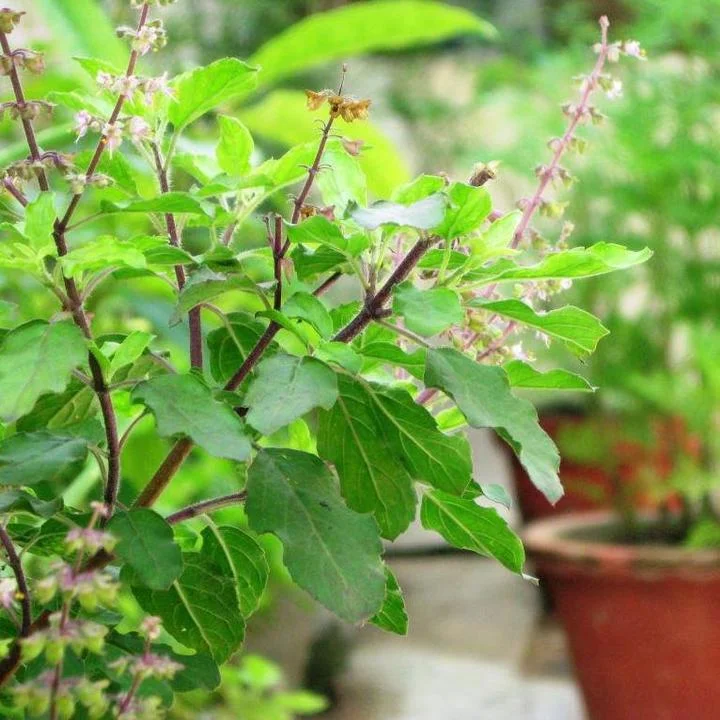BAsil
It's best to grow sweet basil from seed as an annual. All other basil types are perennials. Basil is good fresh, frozen, or dried. It pairs equally well with tomatoes or strawberries, and amps up the flavor of salad, pizza, pasta, you name it. Plus, basil smells so good many fans are happy just sticking it in a vase of water and letting it fill a room with its fragrance.
VarietiEs
The most popular variety, Sweet Basil, is an annual. The rest are perennial varieties you can enjoy without having to replant it each year. Lemon or wild basil is an American native that grows up to three feet tall. Camphor is a basil native to Asia with sweet scented white flowers. Thai Lemon basil is a mainstay in Laos and Indonesia where the zesty seeds, stems, and leaves are all used in the kitchen. Hoary Basil, an African native, has a strong taste and often used as an herbal tea. And Tulsi, or Holy Basil, originally from India, is used in Ayurvedic medicine to offset stress.
WHERE BASIL THRIVES
Regional compatibility
Basil prefers moderate temperatures and won’t do well in regions that experience extreme cold.
Optimal shade & sun
Grow basil in the sunshine but make sure it gets shade, too. Afternoon shade is better than morning shade.
RESILIENCE
ADAPTABILITY TO CLIMATE EXTREMES. Basil is adaptable to the heat but cannot survive the extreme cold.
DROUGHT RESISTANCE. Basil can survive a drought but only if given plenty of water. This is a plant that needs steady moisture to thrive.
PREP YOUR SOIL
OPTIMAL SOIL TYPE. Basil loves moist soil; it’s not drought tolerant and is prone to heat stress.
PLANTING
If planting from seed, sow your seeds ¼ inch deep in an indoor pot about six weeks before the last frost of spring. Transplant your seedlings after two months of growth approximately two weeks after the final frost. Space your seedlings about one foot apart in the garden.
If you’re growing from cuttings, select a 4-inch, unflowered basil stem and place in water, and be prepared to change your water regularly to keep it fresh. Roots will sprout in about a week, at which point you can transplant the plants into the garden.
If transplanting a plant or cutting, wait until the ground is sufficiently warm to do it (about 70 degrees). A ground thermometer (or any kind of thermometer, really) is a helpful investment for beginning gardeners.
Best time of year to plant
Because basil can be killed by cold weather, your timing is fairly important. If you choose to plant from seed, plant six weeks or less before the last frost of spring. (Check a regional frost chart on timing.) If you’re transplanting plants wait until night time temperatures are reaching the low 50s before moving them outside.
Companion plants
Pair basil with tomatoes, peppers, parsley, lettuce, asparagus, beans, beets, cabbage, eggplant, marigolds, potatoes, or oregano.
Growing
Basil grows well from seed and can quickly reach a height of two feet. Its flavor peaks just before it produces small white flowers in summer. By pinching off the flowers so the plant can focus on growing leaves and not sustaining the blooms you can extend the flavorful period. Another way to maintain flavor is to trim any woody stems.
WATERING
Water basil when the soil is dry to the touch.
Mulching
Some mulch helps keep the soil warm for this cold-sensitive plant but don’t overdo it. Too much organic matter can compromise its flavor.
Fertilizing
Add fertilizer (we recommend compost), at the beginning of the growing season. Do not fertilize throughout the season. As with many other herbs, a too-rich soil can strip the herb of its flavor and aroma.
Weeding
When planting from seed keep the area clear of weeds.
CHALLENGES
PESTS. Aphids, slugs, and Japanese beetles can pose the occasional threat, but pests are not a big concern for basil.
DISEASES. Black spot and root rot can be a concern. Help prevent this by keeping your soil airy and well-drained.
OTHER CHALLENGES. Perennial basil is considered a tender perennial, meaning it can’t really handle the cold. It’s best if you cover your basil plants during cold snaps. Since basil grows well in containers, one option is to keep them in pots and move them inside during cold nights.
Harvest
You can harvest up to two-thirds of your basil plant at a time, or just pick leaves and stems as needed. Regular clipping and harvesting helps maintain a healthy, robust plant.
STORE. For short-term use store in room-temperature water. Don’t refrigerate - it will turn brown.
PRESERVE. Freeze basil in ice cubes for the best long-term flavor additions, or dry it by hanging it in a warm, dark place.
RECIPES
Basil Pesto from The Food Network
Nectarine Basil Pizza from Alexandra's Kitchen
Basil Strawberry Popsicles from A Girl Deflourered












